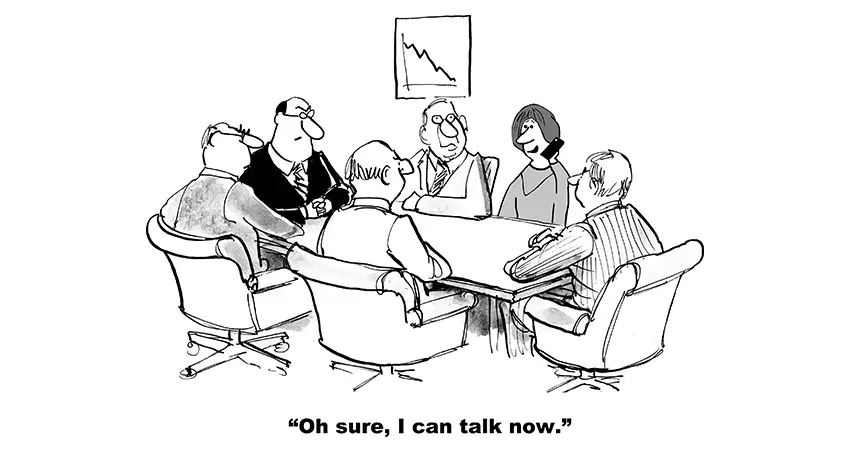Why Poor Phone Etiquette Costs More Than You Think

“The owner is so rude!! He doesn’t know how to talk to customers!”
How often have you seen this comment posted on Yelp, Angi, or maybe your Google Business Profile?
Bad news travels fast — especially news about service screw-ups. Social media gives customers a megaphone and the power to make or break a brand. They’ll share their complaint with the world. One lost sale becomes many.
- 40% of customers begin purchasing from a competitor because of their reputation for great customer service.
- To customers, good service is more important than price.
(Source: Think with Google)
Good Phone Manners Convert Leads to Sales
A plumbing and HVAC company can pay $100 or more for a lead in a competitive market like metro Los Angeles.
And if calls and messages go unanswered, or your tone is brusque, the caller will leave for a competitor with better phone manners.
Let’s review some of the basics of good telephone etiquette for businesses:
- Answer promptly: Don’t make the caller wait. If you can’t answer immediately, use voicemail with a friendly greeting, or consider hiring a professional answering service. Lost business costs far more than a 24/7 phone service.
- Be professional: Introduce yourself by name. State the name of your company. This builds trust and reassures the customer that the call has been routed to the right person and place.
- Speak clearly: The caller should be able to understand you without difficulty. Slow down and enunciate your words. Fast talkers can appear pushy, salesy, or untrustworthy.
- Be friendly: Your voice conveys your attitude, so act and sound like someone the caller would want to do business with. Be genuinely interested in what they have to say.
- Listen carefully: Rather than thinking about what you’ll say next, focus on the caller and what they’re saying. This will help build rapport and address their needs.
- Avoid jargon: Jargon is acceptable among colleagues but can be confusing or off-putting to customers. Use language that everyone understands.
- Take notes: Have a pen and paper handy to jot down key points of the conversation. This shows that you’re paying attention and allows you to follow up on specific details.
- Be helpful: Listen to the problem and offer a practical solution. If you can’t help, refer the caller to someone who can.
- Be patient: Some callers may be upset or angry. Stay calm while you work to resolve the issue.
- Be prepared to transfer the call: If the caller needs to speak to someone else in your company, have that person’s contact information ready.
- End the call politely: Thank the caller for their time and let them know how much you appreciate their business.
These tips may seem obvious, but you’d be surprised how many businesses ignore them. Good phone etiquette builds trust and shows that you’re a company that cares.
It’s Not When You Answer, But How
According to the prevailing wisdom, a business phone should ring no more than two or three times before you answer it.
Anyone offering this advice has never worked at the front desk of a busy plumbing company, where a single call can last 10 minutes or more, and the calls can come in tidal waves (or maybe house floods).
So what’s the magic number? Four rings? Six?
The fewer, the better, and you may already know the number if you can sense a customer’s exasperation when a phone rings too long.
How you answer the phone matters even more than how quickly you respond to it.
Acknowledge the customer’s frustration and apologize for the delay. Thank them for their call, and let them know you’re there to help.
Your tone of voice communicates more than the words you’re speaking. A warm, friendly voice will go a long way toward offsetting any customer frustration.
How an Answering Service Can Help
An answering service can answer calls 24/7, take messages, and route calls to the right person. Every caller is greeted promptly and professionally — even after hours.
It can screen calls, make appointments, and provide administrative support. This frees up your time to focus on running your business.
Several Culture Cube clients use answering services with excellent results. Please call us if you’d like to know more.
Never Put Customers on Hold Without Asking First
Customers don’t like being put on hold, but at times it’s unavoidable. Always ask first.
“May I place you on hold for a minute while I check on that?”
If the answer is no, try to find another way to help the customer. Maybe you can take a message or have someone else call them back.
Use First Names Sparingly, If at All
Using a customer’s first name is personal and intimate. You wouldn’t dare use it unless you were on a first-name basis with the person, right?
Wrong. It often happens in customer service, and it’s almost always inappropriate.
There are exceptions, of course. If you’ve been dealing with a customer for some time and are sure they won’t mind, then go ahead and use their first name.
Otherwise, it’s best to stick to Mr., Ms., or Mrs.
Don’t Get Personal
Remember that your conversation with a customer is a business transaction. You’re not there to make small talk or share your life story.
Stay focused on the task, and resist the urge to get personal. The customer doesn’t need to know that you’re going through a messy divorce.
If the customer wants to chat, wait until the transaction is complete.
Make It Right
If you make a mistake, admit it and make it right. The customer will appreciate your honesty, and they’ll be more likely to do business with you in the future.
There’s no need to offer a discount or a freebie every time something goes wrong, but a little extra effort will go a long way toward keeping your customers happy.
All customers want to be treated well. They want to feel important and know that you’re there to help them.
Be Authentic. Avoid Using a Script
Customers can tell when you’re reading from a script and they don’t like it. It makes them feel like they’re just another number.
If you have to follow a script, ensure it’s flexible enough to allow for spontaneity. And never use a script verbatim. It should be more of a guideline than anything else.
Conclusion
These are just a few tips to improve your customer service. There are others, of course, but our job is to offer a basic guide and not a book.
If you take the time to implement them, you’ll see a positive difference in your interactions on the phone and in customer comments about your business online.
A little goodwill goes a long way, and on the phone, as with text messages, where customers can’t read facial expressions and body language, it can mean the difference between a satisfied customer and a frustrated one who takes their business elsewhere.
Or talks smack about you on social media.
About Culture Cube Digital Marketing
Culture Cube specializes in digital marketing for local businesses. Our clients include plumbers, HVAC installers, appliance repair companies, and local newspapers.
We offer the expertise of a large agency at small agency rates.
Because we specialize, we’re better qualified to promote your small business and create the most effective campaigns.
We don’t waste client money on lavish offices, fancy equipment, costly business trips, and endless meetings. We pass our savings on to you and welcome you as a partner more than a client.
Please contact us to learn what we can do for you.

Peter Losh is the SEO Director of Culture Cube Marketing in Upland, California. He's also a de facto UX designer, site builder, and content creator. Unlike most folks in the SEO biz, he works directly on the sites he optimizes, having witnessed the effects of recommendations that go ignored or misunderstood (in previous gigs).
Peter has worked on websites since the salad days of the internet, first as a graphic artist and web designer at the Centers for Disease Control. Then came several years of freelance web development, SEO and e-commerce management for business sites of various sizes, and ultimately a 10-year stint as the sole SEO Manager of PartyCity.com.
In his spare time, he enjoys classic film, classical music, and classic comebacks. And cats.
Professional Work Experience
- Search engine optimization
- Ecommerce management
- Conversion rate optimization
- UX design and analysis
- Copywriting and training
- E-mail campaign design
- Web design and development
- Graphic design

